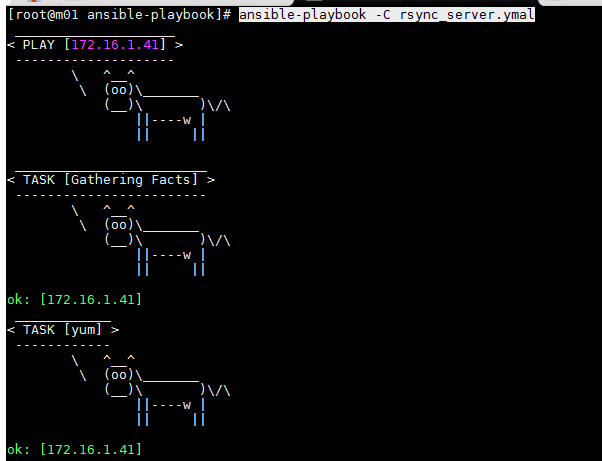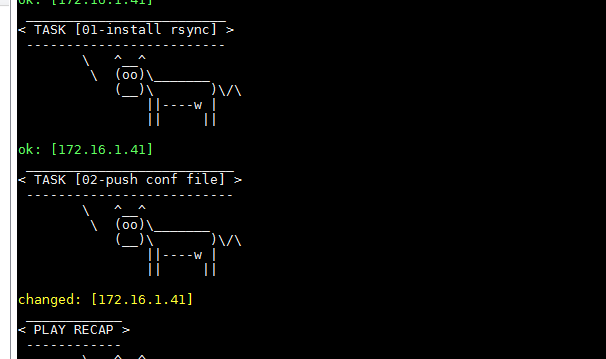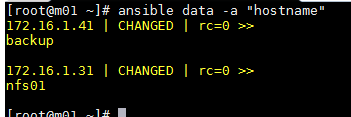linux 综合架构 ansible 剧本
剧本的作用: 可以一键化完成多个任务
剧本编写规范:
(1)合理的信息缩进 两个空格表示一个缩进关系
PS: 在ansible中一定不能用tab进行缩进
标题一 标题二 标题三
(2)冒号的使用方法
PS: 使用冒号时后面要有空格信息
hosts: 172.16.1.41 tasks: yum: name=xx
(3)短横线应用 -(列表功能)
PS: 使用短横线构成列表信息,短横线后面需要有空格
- 张三
男
- 打游戏
- 运动
- 李四
女
学习
湖南
- 王五
男
运动
深圳
使用 ansible 命令手动部署剧本
自动化部署rsync服务: 服务端的操作 第一个历程安装软件: ansible 172.16.1.41 -m yum -a "name=rsync state=installed" 第二个历程编写文件: ansible 172.16.1.41 -m copy -a "src=/xxx/rsyncd.conf dest=/etc/" 第三个历程创建用户 ansible 172.16.1.41 -m user -a "name=rsync create_home=no shell=/sbin/nologin" 第四个历程创建目录 ansible 172.16.1.41 -m file -a "dest=/backup state=directory owner=rsync group=rsync" 第五个历程创建密码文件 ansible 172.16.1.41 -m copy -a "content='rsync_backup:oldboy123' dest=/etc/rsync.password mode=600" 第六个历程启动服务 ansible 172.16.1.41 -m service -a "name=rsyncd state=started enabled=yes" 客户端的操作: 第一个历程: 创建密码文件 ansible 客户端地址 -m copy -a "content='rsync_backup:oldboy123' dest=/etc/rsync.password mode=600"
开始编写剧本
mkdir /etc/ansible/ansible-playbook cd /etc/ansible/ansible-playbook
编写 rsync_server.ymal
- hosts: 172.16.1.41
tasks:
- yum: name=rsync state=installed
- copy: src=/etc/hosts dest=/etc/
第一个步骤: 检查剧本的语法格式
ansible-playbook --syntax-check rsync_server.ymal

第二个步骤: 模拟执行剧本
ansible-playbook -C rsync_server.ymal

第三个步骤: 直接执行剧本
ansible-playbook rsync_server.ymal
改写剧本给每个具体的子任务命名
- hosts: 172.16.1.41
tasks:
- name: 01-install rsync
yum: name=rsync state=installed
- name: 02-push conf file
copy: src=/etc/hosts dest=/root/
模拟执行
ansible-playbook -C rsync_server.ymal

配置主机清单
ansible 主机清单配置文件 /etc/ansible/hosts
第一种方式: 分组配置主机信息
[web]
172.16.1.7
[data]
172.16.1.31
172.16.1.41
操作过程
ansible data -a "hostname"

第二种方式: 主机名符号匹配配置
[web] 172.16.1.[7:9] [web] web[01:03]
第三种方式: 跟上非标准远程端口 (ssh服务端口自定义这里是 52113)
[web] web01:52113 172.16.1.7:52113
第四种方式: 主机使用特殊的变量 (在没有分发公钥的情况下使用)
[web] 172.16.1.7 ansible_ssh_port=52113 ansible_ssh_user=root ansible_ssh_pass=123456 [web] web01 ansible_ssh_host=172.16.1.7 ansible_ssh_port=52113 ansible_ssh_user=root ansible_ssh_pass=123456
第五种方式: 主机组名嵌入配置
[rsync:children] --- 嵌入子组信息 rsync_server rsync_client [rsync_server] 172.16.1.41 [rsync_client] 172.16.1.31 172.16.1.7 [web:vars] --- 嵌入式变量信息 ansible_ssh_host=172.16.1.7 ansible_ssh_port=52113 ansible_ssh_user=root ansible_ssh_pass=123456 [web] web01
主机清单的配置方法
https://docs.ansible.com/ansible/latest/user_guide/intro_inventory.html
rsync服务剧本编写
rsync_server.yaml
- hosts: rsync_server
tasks:
- name: 01-install rsync
yum: name=rsync state=installed
- name: 02-push conf file
copy: src=/etc/ansible/server_file/rsync_server/rsyncd.conf dest=/etc/
- name: 03-create user
user: name=rsync create_home=no shell=/sbin/nologin
#shell: useradd rsync -M -s /sbin/nologin
- name: 04-create backup dir
file: path=/backup state=directory owner=rsync group=rsync
- name: 05-create password file
copy: content=rsync_backup:oldboy123 dest=/etc/rsync.password mode=600
- name: 06-start rsync server
service: name=rsyncd state=started enabled=yes
- hosts: rsync_clients
tasks:
- name: 01-install rsync
yum: name=rsync state=installed
- name: 02-create password file
copy: content=oldboy123 dest=/etc/rsync.password mode=600
- name: 03-create test file
file: dest=/tmp/test.txt state=touch
- name: 04-check test
shell: rsync -avz /tmp/test.txt rsync_backup@172.16.1.41::backup --password-file=/etc/rsync.password
剧本中设置变量信息
方式一:直接在剧本文件编写
vars: oldboy01: data01 oldboy02: data02
方式二:在命令行中进行指定
# -e 简写 ansible-playbook --extra-vars=oldboy01=data01
方式三:在主机清单文件编写
[oldboy] oldboy01=data01 oldboy02=data02
三种变量设置方式都配置了,三种方式的优先级
-
最优先: 命令行变量设置
-
次优先: 剧本中变量设置
-
最后: 主机清单变量设置
如何全局设置变量: roles 剧本整合
剧本中设置注册信息
功能:输出信息

显示进程信息,表示服务已经正常启动
在剧本中设置判断信息
如何指定判断条件: when
- hosts: oldboy
remote_user: root
tasks:
- name: Check File
file: path=/tmp/this_is_{{ ansible_hostname }}_file state=touch
when: (ansible_hostname == "nfs") or (ansible_hostname == "backup")
- name: install httpd
yum: name=httpd state=installed
when: (系统情况 == "CentOS")
- name: install httpd2
yum: name=httpd2 state=installed
when: (系统情况 == "ubuntu")
获取内置变量方法
ansible web -m setup -a "filter=ansible_hostname"

常见主机信息
-
ansible_all_ipv4_addresses: 仅显示ipv4的信息。
-
ansible_devices: 仅显示磁盘设备信息。
-
ansible_distribution: 显示是什么系统,例:centos,suse等。
-
ansible_distribution_major_version: 显示是系统主版本。
-
ansible_distribution_version: 仅显示系统版本。
-
ansible_machine: 显示系统类型,例:32位,还是64位。
-
ansible_eth0: 仅显示eth0的信息。
-
ansible_hostname: 仅显示主机名。
-
ansible_kernel: 仅显示内核版本。
-
ansible_lvm: 显示lvm相关信息。
-
ansible_memtotal_mb: 显示系统总内存。
-
ansible_memfree_mb: 显示可用系统内存。
-
ansible_memory_mb: 详细显示内存情况。
-
ansible_swaptotal_mb: 显示总的swap内存。
-
ansible_swapfree_mb: 显示swap内存的可用内存。
-
ansible_mounts: 显示系统磁盘挂载情况。
-
ansible_processor: 显示cpu个数(具体显示每个cpu的型号)。
-
ansible_processor_vcpus: 显示cpu个数(只显示总的个数)。
在剧本中设置循环信息
- hosts: all
remote_user: root
tasks:
- name: Add Users
user: name={{ item.name }} groups={{ item.groups }} state=present
with_items:
- { name: 'testuser1', groups: 'bin' }
- { name: 'testuser2', groups: 'root' }
vim test05.yml
- hosts: all
remote_user: root
tasks:
- name: Installed Pkg
yum: name={{ item }} state=present
with_items:
- wget
- tree
- lrzsz
在剧本中设置忽略错误
默认playbook会检查命令和模块的返回状态,如遇到错误就中断playbook的执行,可以加入ignore_errors: yes忽略错误
- hosts: all
remote_user: root
tasks:
- name: Ignore False
command: /bin/false
ignore_errors: yes
- name: touch new file
file: path=/tmp/oldboy_ignore state=touch
剧本中设置标签功能
功能:
-
指定执行哪个标签任务 ansible-playbook --tags=t2 test05.yml
-
跳过指定标签任务 ansible-playbook --skip-tags=t2 test05.yml
- hosts: oldboy
ignore_errors: yes
remote_user: root
tasks:
- name: Check File
file: path=/tmp/this_is_{{ ansible_hostname }}_file state=touch
when: (ansible_hostname == "nfs01") or (ansible_hostname == "backup")
tags: t1
- name: bad thing
command: ech 123
#ignore_errors: yes
tags: t2
- name: install httpd
yum: name=httpd state=installed
when: (ansible_all_ipv4_addresses == ["172.16.1.7","10.0.0.7"])
tags: t3
- name: install httpd2
yum: name=httpd2 state=installed
when: (ansible_distribution == "ubuntu")
tags: t4
剧本中设置触发功能
- hosts: backup
remote_user: root
tasks:
- name: 01 Install rsync
yum: name=rsync state=present
- name: 02 push config file
copy: src=./file/{{ item.src }} dest=/etc/{{ item.dest }} mode={{ item.mode }}
with_items:
- { src: "rsyncd.conf", dest: "rsyncd.conf", mode: "0644" }
- { src: "rsync.password", dest: "rsync.password", mode: "0600" }
notify: restart rsync server
handlers:
- name: restart rsync server
service: name=rsyncd state=restarted
将多个剧本进行整合
方式一:include_tasks: f1.yml
- hosts: all
remote_user: root
tasks:
- include_tasks: f1.yml
- include_tasks: f2.yml
方式二:include: f1.yml
- include:f1.yml - include:f2.yml
方式三:- import_playbook main.yml
- import_playbook: base.yml - import_playbook: rsync.yml - import_playbook: nfs.yml - import_playbook: oxxx.yml - import_playbook: rsync.yml - import_playbook: nfs.yml
编写NFS服务剧本
第一个历程: 创建几个目录
[root@m01 ansible-playbook]# tree nfs-file/ nfs-file/ ├── nfs-client └── nfs-server
第二个历程: 编写剧本信息
[nfs:children] nfs_server nfs_client [nfs_server] 172.16.1.31 [nfs_client] 172.16.1.7 #172.16.1.8 #172.16.1.9
nfs_server.yaml
- hosts: nfs
tasks:
- name: 01-install nfs software
yum:
name: ['nfs-utils','rpcbind']
state: installed
- hosts: nfs_server
#vars:
# Data_dir: /data
tasks:
- name: 01-copy conf file
copy: src=/etc/ansible/ansible-playbook/nfs-file/nfs-server/exports dest=/etc
notify: restart nfs server
- name: 02-create data dir
file: path={{ Data_dir }} state=directory owner=nfsnobody group=nfsnobody
# path: ['data01','data02','data03']
# state: directory
# owner: nfsnobody
# group: nfsnobody
- name: 03-boot server
#service: name=rpcbind state=started enabled=yes
#service: name=nfs state=started enabled=yes
service: name={{ item }} state=started enabled=yes
with_items:
- rpcbind
- nfs
handlers:
- name: restart nfs server
service: name=nfs state=restarted
- hosts: nfs_client
#vars:
# Data_dir: /data
tasks:
- name: 01-mount
mount: src=172.16.1.31:{{ Data_dir }} path=/mnt fstype=nfs state=mounted
- name: 02-check mount info
shell: df -h|grep /data
register: mount_info
- name: display mount info
debug: msg={{ mount_info.stdout_lines }}
ansible程序roles
剧本编写完问题
-
1. 目录结构不够规范
-
2. 编写好的任务如何重复调用
-
3. 服务端配置文件改动,客户端参数信息也自动变化
-
4. 汇总剧本中没有显示主机角色信息
-
5. 一个剧本内容信息过多,不容易进行阅读,如何进行拆分
第一个历程: 规范目录结构
cd /etc/ansible/roles
mkdir {rsync,nfs} --- 创建相应角色目录
mkdir {nfs,rsync}/{vars,tasks,templates,handlers,files} --- 创建角色目录下面的子目录
[root@m01 roles]# tree
.
├── nfs
│ ├── files --- 保存需要分发文件目录
│ ├── handlers --- 保存触发器配置文件信息
│ ├── tasks --- 保存要执行的动作信息文件 ok
│ ├── templates --- 保存需要分发模板文件 模板文件中可以设置变量信息
│ └── vars --- 保存变量信息文件
└── rsync
├── files
├── handlers
├── tasks
├── templates
└── vars
第二个历程: 在roles目录中创建相关文件
( 1 ) 编写tasks目录中的main.yml文件
- name: 01-copy conf file
copy: src=exports dest=/etc
notify: restart nfs server
- name: 02-create data dir
file: path={{ Data_dir }} state=directory owner=nfsnobody group=nfsnobody
# path: ['data01','data02','data03']
# state: directory
# owner: nfsnobody
# group: nfsnobody
- name: 03-boot server
service: name={{ item }} state=started enabled=yes
with_items:
- rpcbind
- nfs
vim main.yml
- include_tasks: copy_info.yml
- include_tasks: create_dir.yml
- include_tasks: boot_server.yml
vim copy_info.yml
- name: 01-copy conf file
copy: src=exports dest=/etc
notify: restart nfs server
vim create_dir.yml
- name: 02-create data dir
file: path={{ Data_dir }} state=directory owner=nfsnobody group=nfsnobody
vim boot_server.yml
- name: 03-boot server
service: name={{ item }} state=started enabled=yes
with_items:;
- rpcbind
- nfs
(2)编写vars目录中的main.yml文件
[root@m01 vars]# vim main.yml Data_dir: /data
(3)编写files目录中的文件
[root@m01 files]# ll total 4 -rw-r--r-- 1 root root 29 May 17 15:23 exports
(4)编写handlers目录中的main.yml文件
vim main.yml - name: restart nfs server service: name=nfs state=restarted
目录中文件编写好汇总结构
[root@m01 nfs]# tree
.
├── files
│ └── exports
├── handlers
│ └── main.yml
├── tasks
│ └── main.yml
├── templates
└── vars
└── main.yml
第三个历程: 编写一个主剧本文件
[root@m01 roles]# cat site.yml
- hosts: nfs_server
roles:
- nfs-server
- hosts: rsync_server
roles:
- rsync
剧本编写常见错误:
-
01. 剧本语法规范是否符合(空格 冒号 短横线)
-
02. 剧本中模块使用是否正确
-
03. 剧本中一个name标识下面只能写一个模块任务信息
-
04. 剧本中尽量不要大量使用shell模块


